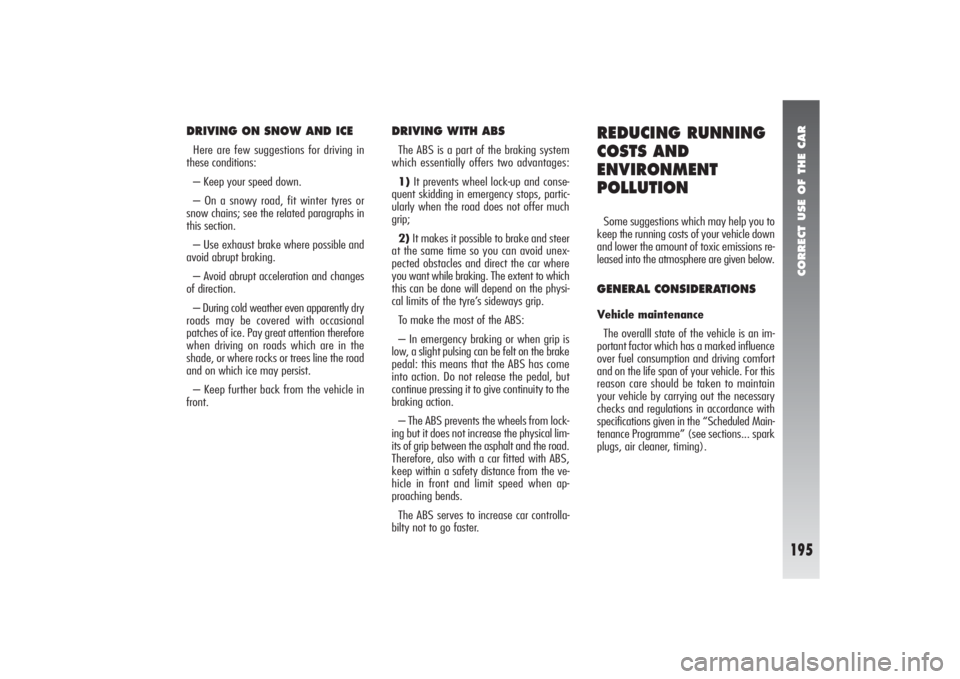change time Alfa Romeo 156 2006 Owner handbook (in English)
[x] Cancel search | Manufacturer: ALFA ROMEO, Model Year: 2006, Model line: 156, Model: Alfa Romeo 156 2006Pages: 357, PDF Size: 5.04 MB
Page 197 of 357

CORRECT USE OF THE CAR
195
DRIVING ON SNOW AND ICEHere are few suggestions for driving in
these conditions:
– Keep your speed down.
– On a snowy road, fit winter tyres or
snow chains; see the related paragraphs in
this section.
– Use exhaust brake where possible and
avoid abrupt braking.
– Avoid abrupt acceleration and changes
of direction.
– During cold weather even apparently dry
roads may be covered with occasional
patches of ice. Pay great attention therefore
when driving on roads which are in the
shade, or where rocks or trees line the road
and on which ice may persist.
– Keep further back from the vehicle in
front.
DRIVING WITH ABSThe ABS is a part of the braking system
which essentially offers two advantages:
1)It prevents wheel lock-up and conse-
quent skidding in emergency stops, partic-
ularly when the road does not offer much
grip;
2)It makes it possible to brake and steer
at the same time so you can avoid unex-
pected obstacles and direct the car where
you want while braking. The extent to which
this can be done will depend on the physi-
cal limits of the tyre’s sideways grip.
To make the most of the ABS:
– In emergency braking or when grip is
low, a slight pulsing can be felt on the brake
pedal: this means that the ABS has come
into action. Do not release the pedal, but
continue pressing it to give continuity to the
braking action.
– The ABS prevents the wheels from lock-
ing but it does not increase the physical lim-
its of grip between the asphalt and the road.
Therefore, also with a car fitted with ABS,
keep within a safety distance from the ve-
hicle in front and limit speed when ap-
proaching bends.
The ABS serves to increase car controlla-
bilty not to go faster.
REDUCING RUNNING
COSTS AND
ENVIRONMENT
POLLUTIONSome suggestions which may help you to
keep the running costs of your vehicle down
and lower the amount of toxic emissions re-
leased into the atmosphere are given below.GENERAL CONSIDERATIONSVehicle maintenance
The overalll state of the vehicle is an im-
portant factor which has a marked influence
over fuel consumption and driving comfort
and on the life span of your vehicle. For this
reason care should be taken to maintain
your vehicle by carrying out the necessary
checks and regulations in accordance with
specifications given in the “Scheduled Main-
tenance Programme” (see sections... spark
plugs, air cleaner, timing).
Page 212 of 357

IN AN EMERGENCY
210
– Take out the tool container (B) and take
it near the wheel to be changed.
– Take the spare wheel (C).
– Remove the wheel cap (A-fig. 3) (for
versions wuth steel rims only).
– Loosen the fastening bolts by approx.
one turn (B-fig. 4).– Place the jack under the car near the
wheel to be changed.
– Work the jack crank (A-fig. 5)to ex-
tend it until the groove (B-fig. 6) on the
upper part of the jack is correctly inserted
on the lower profile of the body (C-fig. 6)
at about 40 cm from the profile of the
wheelhouse.
– Work the jack and raise the car until the
wheel is a few centimetres from the ground.
– Completely unscrew the bolts (B-
fig. 4), and remove the wheel.
– Make sure that the contact surfaces of
the compact spare wheel with the hub are
clean and free of impurities which may lat-
ter cause the fastening bolts to slacken.– Install the spare wheel by matching one
of the holes (A-fig. 7) with the corre-
sponding pin (B-fig. 7).
– Tighten the five fastening bolts.
– Lower the car and remove the jack.fig. 4
A0B0230m
fig. 3
A0B0229m
fig. 5
A0B0231m
fig. 7
A0B0226m
fig. 6
A0B0232m